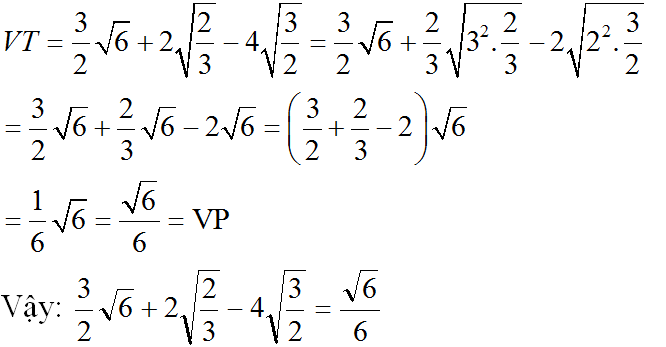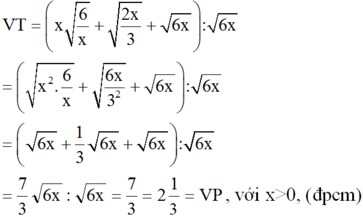
Hãy nhập câu hỏi của bạn vào đây, nếu là tài khoản VIP, bạn sẽ được ưu tiên trả lời.


a: \(VT=\dfrac{3\sqrt{6}}{2}+\dfrac{2\sqrt{6}}{3}-\dfrac{4\sqrt{6}}{2}\)
\(=\dfrac{-\sqrt{6}}{2}+\dfrac{2\sqrt{6}}{3}=\dfrac{-3\sqrt{6}+4\sqrt{6}}{6}=\dfrac{\sqrt{6}}{6}\)
b: \(VT=\dfrac{\left(\sqrt{6x}+\dfrac{\sqrt{6x}}{3}+\sqrt{6x}\right)}{\sqrt{6x}}\)
\(=1+\dfrac{1}{3}+1=2\dfrac{1}{3}\)

a: \(=3\left(x^2+2x+\dfrac{5}{3}\right)\)
\(=3\left(x^2+2x+1+\dfrac{2}{3}\right)\)
\(=3\left(x+1\right)^2+2>=2\)
Dấu '=' xảy ra khi x=-1
b: Lấy x1<x2<-1
\(A=\dfrac{f\left(x_1\right)-f\left(x_2\right)}{x_1-x_2}=\dfrac{3x_1^2+6x_1-3x_2^2-6x_2}{x_1-x_2}\)
\(=3\left(x_1+x_2\right)+6\)
Vì x1<-1, x2<-1 thì x1+x2<-2
=>3(x1+x2)+6<0
=>Hàm số nghịch biến khi x<-1

Lời giải:
a) Ta thấy:
\(y=3x^2+6x+5=3(x^2+2x+1)+2\)
\(=3(x+1)^2+2\)
Vì \((x+1)^2\ge 0, \forall x\in\mathbb{R}\Rightarrow y\geq 3.0+2=2\)
Vậy GTNN của $y$ là $2$ tại \((x+1)^2=0\Leftrightarrow x=-1\)
b)
Xét \(x_1,x_2\in\mathbb{R}|x_1,x_2>-1\). Giả sử \(x_1>x_2\)
Khi đó:
\(y(x_1)-y(x_2)=3x_1^2+6x_1+5-(3x_2^2+6x_2+5)\)
\(=3(x_1^2-x_2^2)+6(x_1-x_2)\)
\(=3(x_1+x_2)(x_1-x_2)+6(x_1-x_2)\)
\(=3(x_1-x_2)(x_1+x_2+2)\)
Vì \(x_1>x_2>-1\Rightarrow x_1-x_2>0; x_1+x_2+2>0\)
Do đó: \(y(x_1)-y(x_2)=3(x_1-x_2)(x_1+x_2+2)>0\Rightarrow y(x_1)>y(x_2)\)
Với mọi \(x_1>x_2>-1\in\mathbb{R}\) thì \(y(x_1)>y(x_2)\) nên hàm số đồng biến với mọi $x>-1$
Chứng minh nghịch biến hoàn toàn tương tự, ta chỉ cần chỉ ra \(y(x_1)< y(x_2)\) theo cách trên là được.



Sai đề ko vậy bạn?